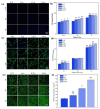Recent Advances in Copper-Doped Titanium Implants
- PMID: 35407675
- PMCID: PMC8999642
- DOI: 10.3390/ma15072342
Recent Advances in Copper-Doped Titanium Implants
Abstract
Titanium (Ti) and its alloys have been extensively used as implant materials in clinical practice due to their high corrosion resistance, light weight and excellent biocompatibility. However, the insufficient intrinsic osteogenic capacity of Ti and its alloys impedes bone repair and regeneration, and implant-related infection or inflammation remains the leading cause of implant failure. Bacterial infections or inflammatory diseases constitute severe threats to human health. The physicochemical properties of the material are critical to the success of clinical procedures, and the doping of Cu into Ti implants has been confirmed to be capable of enhancing the bone repair/regeneration, angiogenesis and antibacterial capability. This review outlines the recent advances in the design and preparation of Cu-doped Ti and Ti alloy implants, with a special focus on various methods, including plasma immersion implantation, magnetron sputtering, galvanic deposition, microarc oxidation and sol-gel synthesis. More importantly, the antibacterial and mechanical properties as well as the corrosion resistance and biocompatibility of Cu-doped Ti implants from different methods are systematically reviewed, and their prospects and limitations are also discussed.
Keywords: biocompatibility; copper doping; implant; implant–bacteria interactions; synthetic methods; titanium and titanium alloys.
Conflict of interest statement
The authors declare no conflict of interest.
Figures








Similar articles
-
Biofunctional Elements Incorporated Nano/Microstructured Coatings on Titanium Implants with Enhanced Osteogenic and Antibacterial Performance.Adv Healthc Mater. 2020 Dec;9(23):e2000681. doi: 10.1002/adhm.202000681. Epub 2020 Sep 2. Adv Healthc Mater. 2020. PMID: 32875743 Review.
-
Microstructure, Wettability, Corrosion Resistance and Antibacterial Property of Cu-MTa2O5 Multilayer Composite Coatings with Different Cu Incorporation Contents.Biomolecules. 2019 Dec 31;10(1):68. doi: 10.3390/biom10010068. Biomolecules. 2019. PMID: 31906220 Free PMC article.
-
In vitro and in vivo studies of anti-bacterial copper-bearing titanium alloy for dental application.Dent Mater. 2018 Aug;34(8):1112-1126. doi: 10.1016/j.dental.2018.04.007. Epub 2018 Apr 27. Dent Mater. 2018. PMID: 29709241
-
Cu-Co Co-Doped Microporous Coating on Titanium with Osteogenic and Antibacterial Properties.J Biomed Nanotechnol. 2021 Jul 1;17(7):1435-1447. doi: 10.1166/jbn.2021.3120. J Biomed Nanotechnol. 2021. PMID: 34446146
-
Titanium and titanium alloys in dentistry: current trends, recent developments, and future prospects.Heliyon. 2022 Oct 28;8(11):e11300. doi: 10.1016/j.heliyon.2022.e11300. eCollection 2022 Nov. Heliyon. 2022. Retraction in: Heliyon. 2024 May 27;10(11):e31978. doi: 10.1016/j.heliyon.2024.e31978. PMID: 36387463 Free PMC article. Retracted. Review.
Cited by
-
Corrosion resistance of multilayer silane sol-gel coatings on titanium Grade 2 and Ti6Al4V alloy.Sci Rep. 2025 May 17;15(1):17191. doi: 10.1038/s41598-025-01915-1. Sci Rep. 2025. PMID: 40382459 Free PMC article.
-
Surface-modified titanium and titanium-based alloys for improved osteogenesis: A critical review.Heliyon. 2023 Dec 18;10(1):e23779. doi: 10.1016/j.heliyon.2023.e23779. eCollection 2024 Jan 15. Heliyon. 2023. PMID: 38223705 Free PMC article. Review.
-
3D-Printed Titanium Trabecular Scaffolds with Sustained Release of Hypoxia-Induced Exosomes for Dual-Mimetic Bone Regeneration.Adv Sci (Weinh). 2025 Jun;12(23):e2500599. doi: 10.1002/advs.202500599. Epub 2025 May 11. Adv Sci (Weinh). 2025. PMID: 40349160 Free PMC article.
-
A Comprehensive Review of the Contemporary Methods for Enhancing Osseointegration and the Antimicrobial Properties of Titanium Dental Implants.Cureus. 2024 Sep 5;16(9):e68720. doi: 10.7759/cureus.68720. eCollection 2024 Sep. Cureus. 2024. PMID: 39238921 Free PMC article. Review.
-
Titanium particles in peri-implantitis: distribution, pathogenesis and prospects.Int J Oral Sci. 2023 Nov 23;15(1):49. doi: 10.1038/s41368-023-00256-x. Int J Oral Sci. 2023. PMID: 37996420 Free PMC article. Review.
References
-
- Liu L., Wu L., Chen X., Sun D., Chen Y., Zhang G., Ding X., Pan F. Enhanced protective coatings on Ti-10V-2Fe-3Al alloy through anodizing and post-sealing with layered double hydroxides. J. Mater. Sci. Technol. 2020;37:104–113.
-
- Geetha M., Singh A.K., Asokamani R., Gogia A.K. Ti based biomaterials, the ultimate choice for orthopaedic implants—A review. Prog. Mater. Sci. 2009;54:397–425.
-
- Dorkhan M., de Paz L.E.C., Skepö M., Svensäter G., Davies J.R. Effects of saliva or serum coating on adherence of Streptococcus oralis strains to titanium. Microbiology. 2012;158:390–397. - PubMed
Publication types
LinkOut - more resources
Full Text Sources

